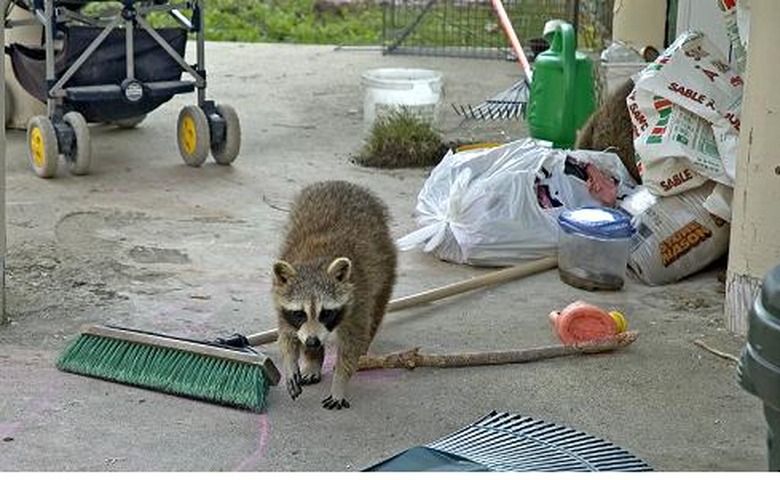How To Repel Raccoons
Things Needed
- Chimney cap
- Variety of hot peppers and spices
- Spray bottle (2 qts. or larger)
- Ammonia
- Wire mesh
- Fence poles
- Wood
- Saw
- Hammer
- Nails
- Staple gun and staples
Tip
Remove attractants. Trash cans should be tightly closed. Place a heavy brick on top of each one, or use a bungee strap to hold the lid on. Rubbermaid makes a tough trash can with a threaded lid that screws on. Pour a small amount of ammonia in the bottom of trash cans after emptying them, and the lingering odor will help repel raccoons. Do not leave pet food or water bowls out on the porch or in the garage. Raccoons are very clever, and may figure out your tactics. If one method works for a while and they return, try another method.
Warning
Raccoons are wild animals, and no matter how cute they may seem, they will attack. Mother raccoons are very aggressive if they think their young are being threatened. Marauding raccoons may viciously attack pet dogs and cats who defend their territory or otherwise offend the raccoons.
Raccoons are social creatures, and they may raid in groups. They can be bold, and will come into your garage or patio looking for food. They have been known to use pet doors. Female raccoons may have their babies in an attic or chimney or other dark and deserted part of your house. Learn to understand raccoons' behavior and you can discourage them humanely.
Repel Raccoons from Your Home
Step 1
A raccoon in the chimney eventually leaves to feed. Be ready to install a chimney cap as soon as you see it come out.
- Raccoons are social creatures, and they may raid in groups.
- They can be bold, and will come into your garage or patio looking for food.
Step 2
If a mother and babies are in the chimney, place a bowl of ammonia in the fireplace or stove chamber. Make sure the damper is slightly open to allow the ammonia fumes to rise up the chimney. If you don't smell fumes in the room, they are going up the chimney. In a day or two, the mother will relocate her babies. Then install a chimney cap.
Step 3
Use ammonia also to get rid of attic raccoons. Tie some rags into balls. Soak the balls in ammonia, and place them in the attic, near the eaves and soffit areas where raccoons tend to retreat. Toss the balls into the corners if you can't get to them. Raccoons will usually leave in a day or two. You can re-soak the balls to use them again, or use new ones if necessary.
- If a mother and babies are in the chimney, place a bowl of ammonia in the fireplace or stove chamber.
- In a day or two, the mother will relocate her babies.
Step 4
Close vent holes and repair loose soffits. Raccoons will pry open loose siding or soffits to gain access to the insides of walls or attics. Secure attic air circulation vents with heavy hardware cloth and a staple gun.
Make sure basement openings (windows, coal chutes) are tightly closed.
Repel Raccoons from the Yard and Garden
Step 1
Sprinkle cinnamon, ground dried hot pepper, or ground black pepper around your yard and/or garden to discourage raccoons. Potent spices irritate their keen sense of smell, and they will move on. The spices are safe for garden plants.
- Close vent holes and repair loose soffits.
- Raccoons will pry open loose siding or soffits to gain access to the insides of walls or attics.
Step 2
Make a homemade raccoon-repellent spray. Boil several hot peppers, an onion, and one tablespoon of cayenne pepper in 2 quarts of water for 20 minutes. Strain the liquid and spray it around trash cans, plants, flower beds, tree trunks, and the outside of buildings. Not only is there an unpleasant odor to this mixture, but it is uncomfortable on raccoons' paws and they will learn to stay away. The effects of this spray are temporary, so you'll need to reapply it every 2 or 3 days—or after any rain.
Step 3
Try motion-activated light-and-noise repellents. Most garden centers carry solar-powered ones. They often work best if you use them along with other methods.
- Make a homemade raccoon-repellent spray.
- The effects of this spray are temporary, so you'll need to reapply it every 2 or 3 days—or after any rain.
Step 4
Keep raccoons out of ornamental ponds with motion-activated devices. You may need to construct a wood-framed wire mesh cover to use over your pond at night.
Step 5
A "floppy-top" wire mesh fence may be the answer for the vegetable garden. This style fence is constructed with the lower portion of the mesh stretched across the fence poles in the traditional manner. The floppy part is an extension of the wire mesh that is NOT supported by poles, but is left to flop back over the outside of the fence with the animal's weight, making it impossible for them to climb over. Put a slight bend in the floppy portion so that it leans outward, away from the garden. Use a light-gauge wire mesh for the floppy part; chicken wire or a similar weight hardware screen works well.
- Keep raccoons out of ornamental ponds with motion-activated devices.
- The floppy part is an extension of the wire mesh that is NOT supported by poles, but is left to flop back over the outside of the fence with the animal's weight, making it impossible for them to climb over.
